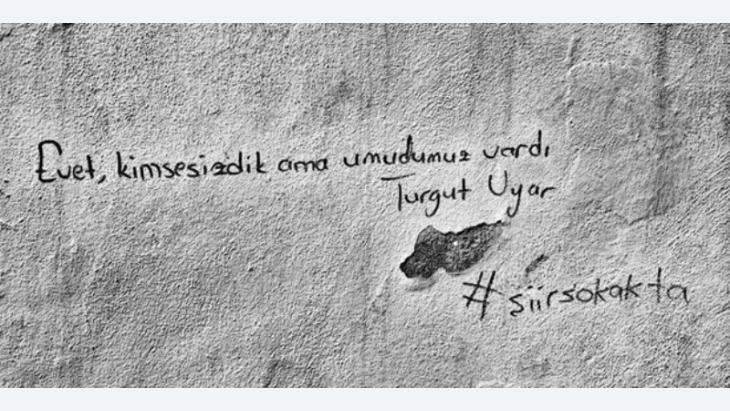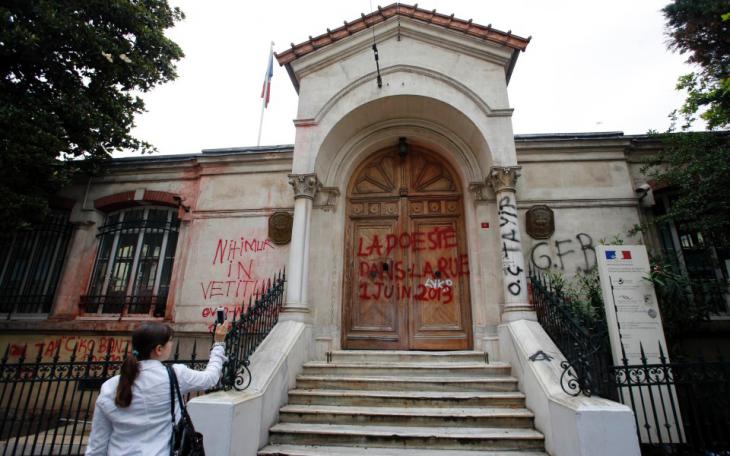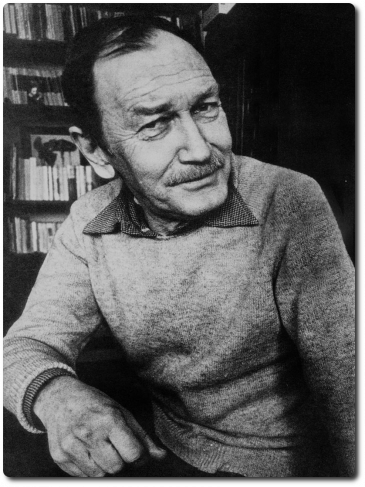The poem is on the street

When protests against a building project in Istanbul's Gezi Park escalated into nationwide demonstrations against the Turkish government on 1 June 2013, someone sprayed the words "La poesie est dans la rue!" ("Poetry is on the street!") in large letters on the wooden entrance to the French Consulate General on Istiklal Caddesi (Independence Street) near Taksim Square in the centre of Istanbul. In the days that followed, this quotation (a quotation from and a reminder of the Paris revolt that followed the student protests of 1968) was taken up by protesters in the Turkish capital, translated into Turkish ("siir sokaktadir", "siir sokaklardadir", "siir sokakta!") and sprayed onto surfaces in public spaces across the city. As was the case in Paris, it began as a figurative expression of the poetic force of street protests and their lyrical beauty.
It was the concept artist Rafet Arslan, who also goes by the name of Bay Persembe (Mr Thursday), who made a small but significant change in the interpretation of this quotation. In the middle of the protests, Arslan took a felt-tipped marker, wrote the slogan "Defteri kapat, siir sokakta!" on the wall of an Istanbul house and added a verse underneath from the poem "Mor Kulhani" ("Purple Hoodlum") by Ece Ayhan. The Turkish word "siir" can be used both as a generic term, meaning "verse" or "poetry" and as a specific term, meaning "poem".
By combining the slogan "Defteri kapat, siir sokakta!" with an extract from a poem, Arslan is actually saying, "Close the copybook, the poem is on the street!" In the weeks and months that followed, this was taken as a call to fill the streets with poems (or individual verses); and the call was passed on.

Poetry and protest
Right from the start, the presence of poetry in the Turkish protests was a striking feature of the civil unrest of the summer of 2013. Protest events featured poetry readings, and quotations from poems cropped up again and again in speeches made at demonstrations.
Nazim Hikmet's famous lines "Yasamak bir agac gibi tek ve hur / ve bir orman gibi kardescesine / bu hasret bizim..." ("To live like a tree alone and free / Like a forest in brotherhood / This yearning is ours!") appeared on printed and handwritten placards and banners carried by protesters in Gezi Park, whose trees were supposed to be chopped down. Hikmet's verses spread via social media, were sprayed over large areas on the promenade in Alsancak in Izmir and used on placards and banners in Kugulu Park, the heart of the resistance movement in Ankara.
When the first demonstrators died in early June, several verses from Hasan Huseyins Korkmazgil's well-known poem "Haziranda olmek zor" ("It is hard to die in June"), which was originally written for Orhan Kemal and Nazim Hikmet, were reproduced in social media and in public spaces as an expression of sadness.
Later on, two four-line poems by Ataol Behramoglu were handwritten on a huge banner and hung on a pole above the temporary memorial for those killed in the protests.
One photo that gained considerable notoriety showed a young female demonstrator with a homemade placard that read "Turgut Uyar'in dizeleriyiz!" ("We are the verses of Turgut Uyar!"). The phrase is an ironic twist on a well-known slogan used by the Kemalists, the supporters of Mustafa Kemal Ataturk, the founder of the Turkish republic: "Mustafa Kemal'in askerleriyiz!" ("We are the soldiers of Mustafa Kemal", a reference to the Turkish War of Independence).
An expression of individuality

Like the poet Ece Ayhan who was quoted by Rafet Arslan, Turgut Uyar, the poet mentioned on the young woman's placard, was part of a lyrical avant-garde movement that began in the 1950s and became known as the "Ikinci Yeni" (the "Second New").
The poets of the "Second New" were opposed to the use of simple language in poetry, as postulated and applied by the preceding movement, "Garip" ("strange") – as well as the "Birinci Yeni" ("First New") – to which Orhan Veli Kanik, Oktay Rifat and Melih Cevdet belonged. They also rejected the making of direct political statements and the expression of political opinions in poems. In this respect, the reference to poets of the "Second New" during the political protests in Gezi Park might initially seem surprising. However, it highlights the key concern of some of the protesters, namely the desire to lead an individual life without constant interference from the state or politicians and without being told what to do in a patriarchal, authoritarian manner. It also expresses the yearning for another world that is frequently found in the often surreal verses of the poets of the "Second New".
When a popular Facebook page run by an anonymous group dedicated to the Ikinci Yeni movement and named after it posted photos of Rafet Arslan's graffiti and the woman with the Turgut Uyar placard, the slogans featured in the photos were widely shared on the web and were soon reproduced again and again in sprayed or handwritten form on the streets.
After the Gezi protests ended, a student organisation put up stickers around parks and on the streets bearing Arslan's phrase "Close the copybook, the poem is on the street!" These stickers were a call for people to continue filling the public realm with poems.
In early September 2013, the people behind the above-mentioned Ikinci Yeni page started a Twitter account, also run anonymously, with the name "siir sokakta!" and introduced the hashtag #siirsokakta. This launch was accompanied by brief manifestos which noted reflectively that while verse could not, of course, provide immediate leverage against the current negative social situation, as street art it could perhaps contribute in the long term by giving people food for thought and triggering small changes for the better. People were also explicitly called on to write poems or individual verses on streets, walls, benches and phone boxes as Rafet Arslan had done: using a felt-tipped pen and the smallest possible handwriting, as if writing in a copybook.
Rapid spread
The introduction of the hashtag, the gathering under a single link of photographic evidence of verse written in public areas, the fact that it was possible to view and share this evidence of what was happening on the streets with one simple click, which provided people with the impetus to get involved themselves, meant that within just a few weeks, a whole movement had emerged. This movement was driven mainly by schoolchildren and students, who have been writing verse on public surfaces in Turkey on a large scale ever since. Initially, only a few hundred people got involved. After a few months, though, several thousand people – and later still tens of thousands – were taking part.
Several other factors contributed to the rapid growth of the movement. Regardless of their political, ethnic and religious affiliation, young poetry-lovers all across the country were united by the initial focus on the Ikinci Yeni poets Cemal Sureya, Turgut Uyar, Edip Cansever, Ece Ayhan and Ilhan Berk, coupled with the abstinence from direct political statement. While the Gezi protests and the government's reaction to these protests divided Turkey into two irreconcilable camps, the #siirsokakta movement did at least succeed in building a little bridge for the younger generation, allowing them to overcome the gulf that still exists.
First reports in the country's major daily newspapers in October 2013 introduced the movement to an older audience that was not as au fait with social media as the young generation, enabling it to gain "activists" and "multipliers" in this population group as well.
In November 2013, a student called Nuhat Elce set up another Twitter account dedicated exclusively to the poetic happenings on the streets and the corresponding hashtag. For several months, Nuhat Elce invested hours of work each day forwarding and publishing the photo material sent to his account or found under the Twitter link. Both Twitter addresses now have six-digit followings.
Numerous other accounts dedicated to the movement subsequently opened on Twitter, Facebook and Instagram. There were (and still are) regular reports and features on #siirsokakta, both online and in print media, in everything from daily newspapers to fanzines.

Poetry on the streets
These days you can't miss the poetry expressed as street art in Turkish cities. For several months the verses of Cemal Sureya, such as "Hayat kisa, / Kuslar ucuyor" ("Life is short, / birds are flying"), and Turgut Uyar, such as "Ikimiz birden sevinebiliriz goge bakalim" ("We can both suddenly be happy – let us look up at the sky") were the most frequently written on public surfaces. However, the continual growth of the movement means it is now possible to read virtually the entire canon of modern Turkish verse on the street (or, of course, its reflection on the Internet). All of them are there: from Tevfik Fikret to the poets of the Garip movement; from Ahmed Arif, Nilgun Marmara, Ozdemir Asaf and Can Yucel to Attila Ilhan and well-known contemporary poets such as Gulten Akin, Haydar Ergulen and Birhan Keskin. In fact, it is thanks to #siirsokakta and its ilk that the verses of the Ankara-born poet Arkadas Z. Ozger, who died in 1973 at the age of 25, have been introduced to a wider audience.
The main hubs of this lyrical movement are of course Turkey's three major cities, Istanbul, Ankara and Izmir, with their large student populations – many university campuses have themselves become like walk-in poetry anthologies – but it is active nationwide, even in the small towns.
Poems and verses written in Kurdish can now be found on the streets, as can the first efforts of budding poets.
Larger-scale works pop up again and again, sometimes sprayed or painted across the entire side of a building, but it is the verses written on public surfaces in felt-tipped pen (usually accompanied by the siirsokakta hashtag) that have become the movement's trademark.

The reaction of the authorities
The authorities in these cities are now targeting not only critical political slogans in the public realm but also these lines of poetry, covering them with grey paint wherever they find them. This means that, especially in the city centres, many #siirsokakta quotations can only be seen and read for a very short space of time. However, this arouses the spirit of resistance in these young poetry lovers, and it is often the case that new lines of poetry appear shortly afterwards in the very same place. It's an attitude exemplified by something written in November 2014 on a surface near the Tunel (Istanbul, Beyoglu) that had been painted over by the city authorities: "And even if you delete a thousand times / We will write again a thousand and one times / Close the copybook, the book / #siirsokakta".
Achim Wagner
© Goethe-Institut e. V., Fikrun wa Fann 2015
Achim Wagner, born in Coburg in 1967, lives as a freelance writer and photographer in Ankara and Berlin. In 2014, his book of photographs on this subject, entitled siir sokakta, was published by Nika Yayinevi, Ankara.